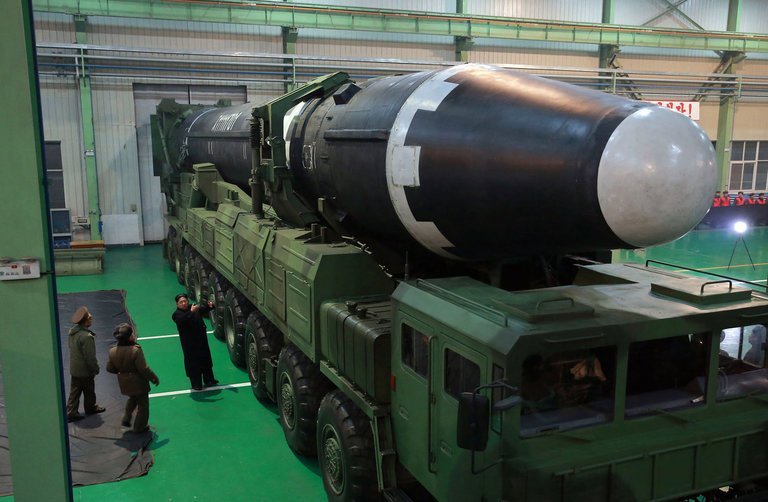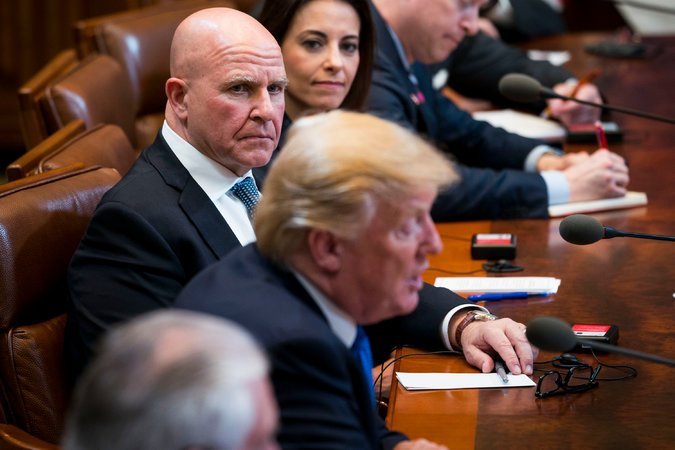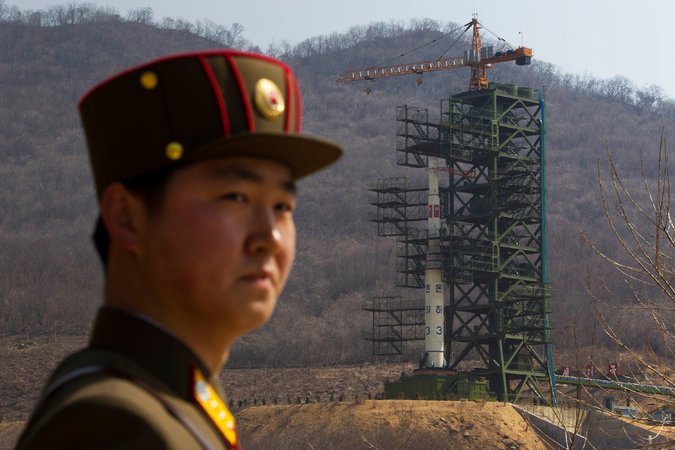
WASHINGTON — At the start of Donald Trump’s presidency, American intelligence agencies told the new administration that while North Korea had built the bomb, there was still ample time — upward of four years — to slow or stop its development of a missile capable of hitting an American city with a nuclear warhead.
The North’s young leader, Kim Jong-un, faced a range of troubles, they assured the new administration, giving Mr. Trump time to explore negotiations or pursue countermeasures. One official who participated in the early policy reviews said estimates suggested Mr. Kim would be unable to strike the continental United States until 2020, perhaps even 2022.
Mr. Kim tested eight intermediate-range missiles in 2016, but seven blew up on the pad or shattered in flight — which some officials attributed partly to an American sabotage program accelerated by President Barack Obama. And while the North had carried out five underground atomic tests, the intelligence community estimated that it remained years away from developing a more powerful type of weapon known as a hydrogen bomb.
Within months, those comforting assessments looked wildly out of date.
At a speed that caught American intelligence officials off guard, Mr. Kim rolled out new missile technology — based on a decades-old Soviet engine design, apparently developed in a parallel program — and in quick succession demonstrated ranges that could reach Guam, then the West Coast, then Washington.
And on the first Sunday in September, he detonated a sixth nuclear bomb. After early hesitation among analysts, a consensus has now emerged that it was the North’s first successful test of a hydrogen weapon, with explosive force some 15 times greater than the atom bomb that leveled Hiroshima.
Continue reading the main story
ADVERTISEMENT
Continue reading the main story
The C.I.A. and other American intelligence services had predicted this moment would come, eventually. For decades, they accurately projected the broad trajectory of North Korea’s nuclear program. Yet their inability to foresee the North’s rapid strides over the past several months now ranks among America’s most significant intelligence failures, current and former officials said in recent interviews.
That disconnect — they saw it coming, but got the timing wrong — helps explain the confusion, mixed signals and alarm that have defined how Mr. Trump’s untested national security team has responded to the nuclear crisis.
In an interview, Lt. Gen. H.R. McMaster, Mr. Trump’s national security adviser, acknowledged that Mr. Kim’s race to the finish line — a bid to establish the North as a nuclear power before any negotiations begin or sanctions take a more punishing toll — “has been quicker and the timeline is a lot more compressed than most people believed.”
As a result, he argued, “we have to do everything we are doing with a greater degree of urgency, and we have to accelerate our own efforts to resolve the issue short of conflict.”
Senior intelligence officials said they began investing more heavily in acquiring information on North Korea’s weapons program in 2012, reaping benefits over the past two years. But they acknowledged they made two key assumptions that proved wrong.
They assumed that North Korea would need about as much time to solve the rocket science as other nations did during the Cold War, underestimating its access to both advanced computer modeling and foreign expertise. They also misjudged Mr. Kim, 33, who took control of the dynastic regime in late 2011 and made the weapons program more of a priority than his father or grandfather did.

Mr. Obama warned Mr. Trump during the transition a year ago that North Korea would pose the most urgent national security threat, and almost immediately the newly installed president began repeating, publicly and privately, that he inherited “a mess” in North Korea because his predecessors did not do enough.
Former officials in the Obama administration dispute that. But some concede that the intelligence community’s flawed assessment of the North’s progress meant there was less pressure to bolster missile defenses, more vigorously enforce sanctions or consider stepped-up covert action.
It is not clear that even with more advanced warning the Obama or Trump administrations would have been able to slow Mr. Kim’s progress.
Over many years, the North Koreans have outmaneuvered several American presidents — Republicans and Democrats alike — with technological advances that seemed highly threatening but not worth the risk of a war that could kill millions in South Korea and Japan. A beefed-up military presence off the North Korean coast, cyberattacks, sabotage of imported parts and simulated bombing runs may have slowed but ultimately failed to stop the country’s nuclear program.
Now, facing the biggest advances of all, Mr. Trump faces the same dilemma his predecessors did, but with less time to respond.
And the shakiness of intelligence on North Korea — even on fundamental questions like how many nuclear weapons Mr. Kim possesses — casts a shadow over Mr. Trump’s options going forward.
He has repeatedly raised the prospect of war with North Korea. He has also ordered up a range of new military plans, from a limited “punch in the nose” to signal American resolve to a large-scale attack aimed at destroying the country’s nuclear and missile facilities — all of which, his aides worry, could trigger a devastating wider conflict.
Yet many in the Pentagon see the failure to anticipate the North’s recent breakthroughs as an ominous reminder of how much could go wrong. A successful pre-emptive strike, for example, might require precise knowledge of the locations of manufacturing facilities, nuclear plants and storage areas, and confidence that cyberstrikes and electronic strikes would cripple Mr. Kim’s ability to retaliate.
The past year, one senior administration official said, had been a “humbling lesson” in the limits of American electronic, satellite and human intelligence operations against a sealed-off society with few computer networks, a high degree of paranoia about American covert action, and a determined young leader.
Mr. Trump, however, was not disturbed by the absence of warning, General McMaster said. “He doesn’t have the expectation of perfect intelligence about anything. He is very comfortable with ambiguity. He understands human nature and understands he will never have perfect intelligence about capabilities and intentions.”
The North’s rapid progress raises a number of awkward questions: Did the American sabotage effort, for example, prompt Mr. Kim to scrap an ailing missile program for a new generation of more capable rocket engines? Or was that his plan all along? And does the new program have similar vulnerabilities the United States can exploit?
During a talk last fall, Gen. John E. Hyten, who heads the United States Strategic Command, which controls the American nuclear arsenal, acknowledged he had no idea when North Korea would pass its final technological hurdle: proving its warheads can survive fiery re-entry into the atmosphere to hit targets in the United States.

“Will they get there in 2017, 2018, 2019?” he asked rhetorically. “I see a lot of the detailed intel. I can honestly tell you, I don’t know the answer.”
Missing Critical Turns
Ever since the United States began tracking North Korea’s efforts to obtain a nuclear weapon, a pattern has repeated itself: American intelligence agencies excelled at forecasting the direction and overall timeline of the program, yet repeatedly missed critical turns.
Recently declassified documents show the C.I.A. recognized the North’s ambitions in the early 1980s, when spy satellites first spotted evidence that it was building a reactor to produce plutonium, a main fuel for nuclear arms. A division of the agency immersed itself in studying the North’s factories and reactors, trying to gauge how fast the backward state could build advanced rocket engines, specialty fuels and nuclear warheads.
After the collapse of the Soviet Union, waves of its impoverished missile scientists began to head for North Korea. While Russian security forces intercepted some, others made it out or assisted the North from afar. In retrospect, former American intelligence officials say they almost certainly missed significant transfers of technology.
“These are designs you can put on a thumb drive,” said a senior official who has tracked North Korea for years and spoke on condition of anonymity because of the topic’s sensitivity.
ADVERTISEMENT
Continue reading the main story
The missiles Mr. Kim has launched in recent months bear numerous signs of Soviet provenance. But analysts and intelligence officials say the specific dates, places and means of transfer remain murky.
Ostensibly, North Korea suspended its nuclear weapons program in 1994 after a tense standoff with the United States that brought the two countries closer than ever — until recent months — to resuming the Korean War. With the Clinton administration weighing military options, former President Jimmy Carter negotiated a deal that ultimately resulted in a freeze of the North’s nuclear program in exchange for fuel oil and the construction of nuclear power plants, which ultimately were never built.
That deal appeared to hold for six years but, in fact, the North began cheating on the agreement within a few years. Secretly, it was pursuing an alternative path to the bomb using uranium fuel.
The intelligence community eventually spotted shipments from Russia and Pakistan containing parts for centrifuges used to enrich uranium. Confronted with the evidence, North Korea acknowledged the program, prompting the Bush administration to suspend the agreement. But the North pressed ahead, and today analysts believe it uses uranium for many of its new warheads.
From as early as 2000, the National Intelligence Council was remarkably prescient about North Korea’s overall direction, predicting in an unclassified report that it would “most likely” have a nuclear missile that could hit American cities by 2015.
Four years later, when the United States was mired in the first year of the Iraq war, the council refined its prediction, saying a “crisis over North Korea is likely to come to a head sometime over the next 15 years,” that is, no later than 2019.
None of this was ignored. President George W. Bush began a program to interdict ships delivering material for the North’s weapons program, and he accelerated secret efforts to cripple the program by sabotaging its supply chain with bad parts.
Hi! I am a robot. I just upvoted you! I found similar content that readers might be interested in:
https://www.adn.com/nation-world/2018/01/06/how-north-koreas-nuclear-pace-caught-the-u-s-off-guard/